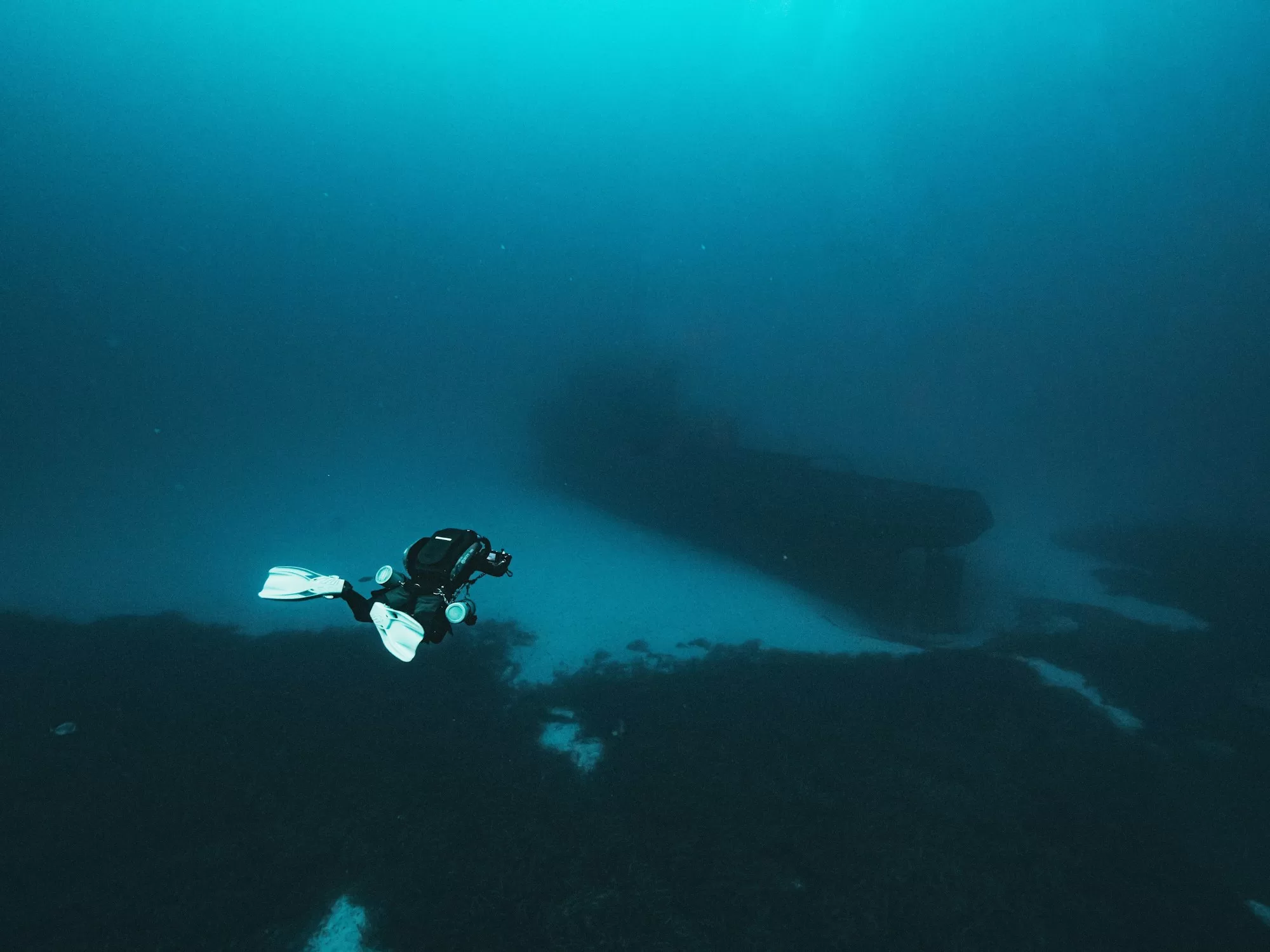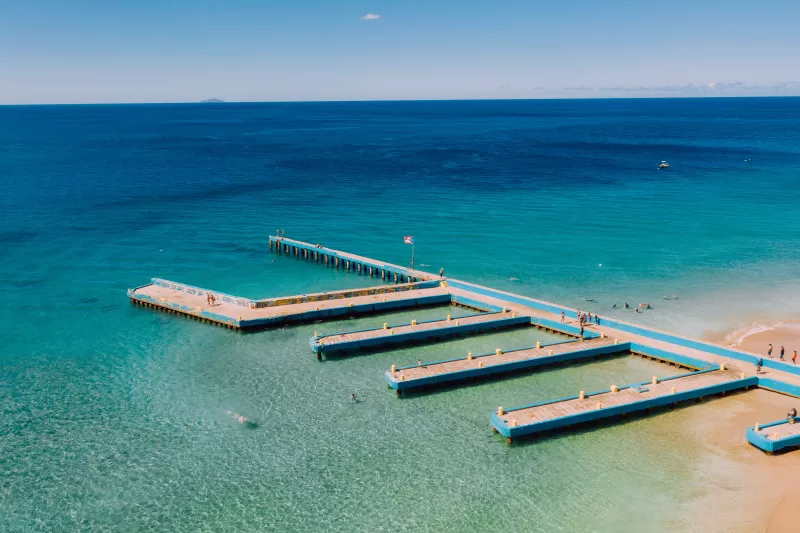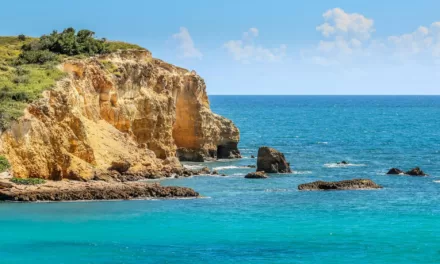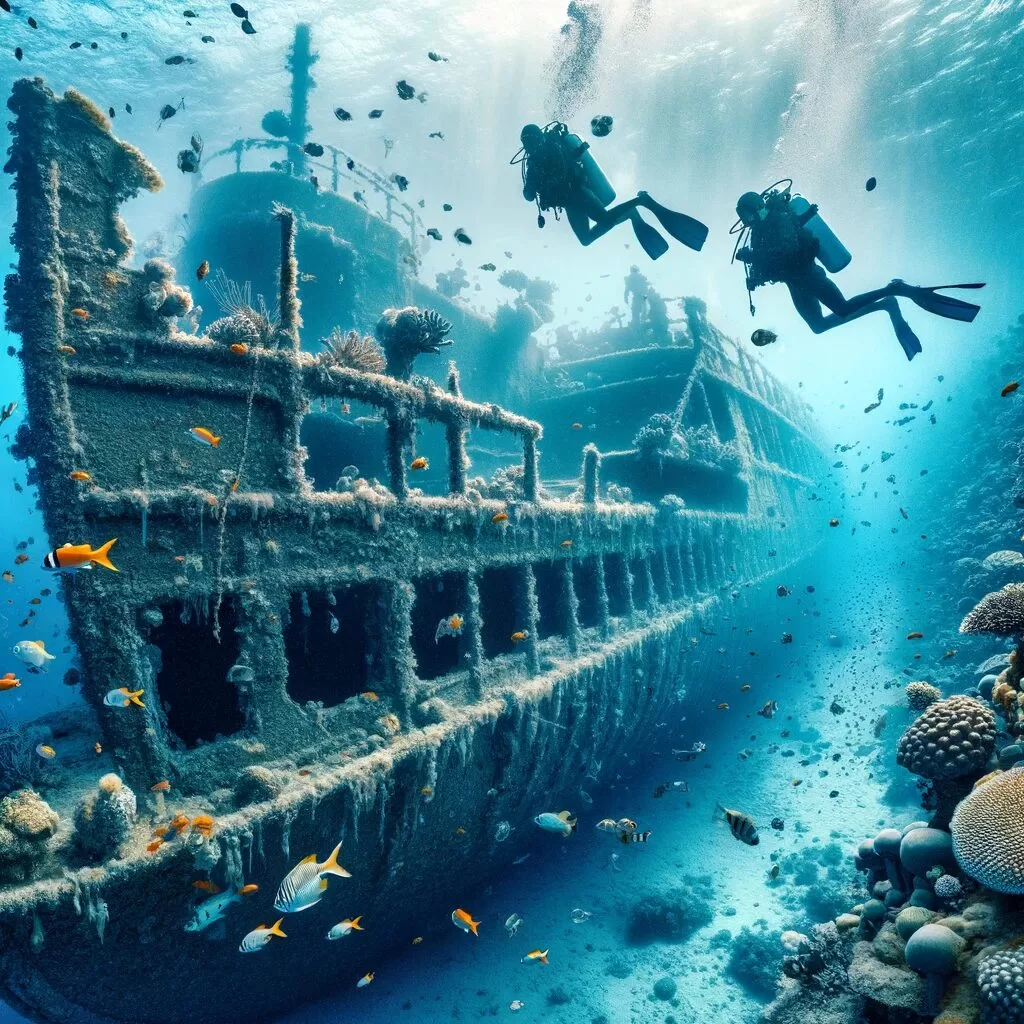Imagine submerging into the crystal-clear Caribbean waters, where history and adventure blend seamlessly beneath the waves. This is the world of shipwreck diving, a realm where each dive is a journey back in time, and every submerged vessel tells a story. Welcome to Puerto Rico, an island not just rich in culture and beauty, but also a hidden gem for underwater explorers seeking the thrill of shipwreck diving.
Puerto Rico, with its inviting tropical climate and diverse marine life, offers more than just picturesque beaches and vibrant coral reefs. Hidden beneath its azure waters lies a treasure trove of sunken ships, each holding secrets of the past, waiting to be discovered. From ancient galleons that once roamed the high seas to modern vessels that met their fate in these waters, Puerto Rico presents a diverse underwater landscape for divers of all levels. Whether you’re a seasoned diver or just starting, the island’s numerous shipwreck sites provide an extraordinary backdrop for an unforgettable diving experience.
The History and Appeal of Shipwreck Diving
The allure of shipwreck diving lies in its unique blend of history, adventure, and the unknown. Divers are drawn to these underwater time capsules for various reasons: the thrill of exploring forgotten wrecks, the chance to witness marine life reclaiming these man-made structures, or the simple curiosity about the past. Each dive offers a chance to connect with history, to touch a piece of a bygone era that has been lost to the sea.
Around Puerto Rico, the ocean floor is dotted with shipwrecks from different epochs, each with its own story. Notable among these is the Antilla, a casualty of World War II, now a haven for aquatic life and one of the Caribbean’s largest and most famous wrecks. Then there’s the mysterious and older Spanish galleons, whose remains whisper tales of the island’s early colonial days. These wrecks not only offer a glimpse into the past but also serve as artificial reefs, creating habitats for a variety of marine species.
Exploring these submerged vessels around Puerto Rico is like opening a book to a page in history. Each dive is an opportunity to learn about the ship’s origin, its journey, and ultimately, its demise. The experience is not just about the thrill of discovery, but also about appreciating the stories and the life that these wrecks have nurtured over the years. As we delve into the depths, we’re reminded of the power of nature to reclaim and transform, turning these remnants of human endeavor into thriving ecosystems.
Puerto Rico’s Shipwreck Hotspots
Puerto Rico is a diver’s paradise, boasting an array of shipwreck sites, each with its unique charm and story. The island’s waters serve as a final resting place for a variety of vessels, offering an exciting mix of historical and ecological exploration.
1. The Antilla Wreck: Off the coast of Isla Verde, the Antilla, a German freighter scuttled in 1942, lies in wait. This WWII relic is now a vibrant artificial reef, home to a kaleidoscope of marine life. The Antilla’s vast size and relatively shallow depth make it ideal for both beginners and experienced divers.
2. Mona Island: Often referred to as the “Galapagos of the Caribbean,” Mona Island hosts several shipwrecks, including the much-visited ‘Pirate Shipwreck’. Surrounded by pristine reefs and abundant wildlife, this site offers an exhilarating mix of history and natural beauty.
3. Desecheo Island: Known for its crystal-clear visibility, Desecheo Island offers a unique diving experience with its shipwrecks often surrounded by schools of vibrant fish. It’s an underwater photographer’s dream and a must-visit for any diving enthusiast.
4. La Parguera: This site is famous for the wreck of the freighter Katherine, which sank in the 1980s. Now encrusted with coral and teeming with sea life, it offers a slightly more challenging dive, suitable for those with intermediate skills.
Preparing for Your Shipwreck Dive
Essential Gear and Preparation: To ensure a safe and enjoyable shipwreck diving adventure in Puerto Rico, the right gear is crucial. At a minimum, you’ll need a diving suit, mask, fins, and an oxygen tank. A dive computer is also recommended to keep track of your depth and time underwater. Don’t forget a waterproof camera to capture the stunning underwater vistas and historic wrecks.
Tips for Beginners:
- Get Certified: If you’re new to diving, ensure you’re properly certified through a recognized diving course.
- Start with Easy Sites: Begin with shallower and less complex wrecks like the Antilla.
- Buddy Up: Always dive with a partner for safety.
Tips for Advanced Divers:
- Explore Deeper Wrecks: Challenge yourself with deeper sites like the Katherine in La Paguera.
- Focus on Buoyancy Control: Mastering buoyancy is crucial for navigating tight spaces in wrecks.
- Be Aware of Your Surroundings: Shipwrecks can be unpredictable environments. Stay alert to avoid getting disoriented or trapped.
Preparing thoroughly and respecting your skill level will ensure that your shipwreck diving experience in Puerto Rico is not only memorable but also safe. Whether you’re marveling at the coral-encrusted hulls or swimming alongside vibrant marine life, these underwater adventures promise to be as enriching as they are exhilarating.
The Underwater Experience: What to Expect
Diving into the waters of Puerto Rico for shipwreck exploration is like entering a different world, where history and marine ecology intertwine. The underwater landscape is as varied as the island’s shipwrecks, ranging from shallow, coral-laden sites to deeper, more challenging wrecks.
Underwater Landscape and Conditions:
- Visibility: The clear Caribbean waters around Puerto Rico typically offer excellent visibility, sometimes extending up to 100 feet, allowing divers to fully appreciate the magnificence of the wrecks and the surrounding marine life.
- Temperature: The water temperature is generally warm, hovering around 75-85°F (24-29°C), making for comfortable dives without the need for thick wetsuits.
- Currents: While many sites have mild currents, suitable for divers of all levels, some locations can experience stronger flows, requiring more experience and skill to navigate.
Marine Life Around Shipwrecks:
The shipwrecks off Puerto Rico are not just historical artifacts; they are thriving ecosystems. Divers can expect to encounter a diverse array of marine life, including:
- Colorful Coral Formations: Many wrecks are adorned with vibrant coral, transforming them into living underwater sculptures.
- Tropical Fish: Schools of bright fish such as angelfish, butterflyfish, and damselfish animate these underwater scenes.
- Larger Marine Creatures: It’s not uncommon to spot larger species like barracudas, nurse sharks, and occasionally, sea turtles, adding a thrill to the diving experience.
Shipwreck Diving: A Conduit to Marine Conservation
Shipwreck diving in Puerto Rico isn’t just an adventurous activity; it plays a significant role in ocean conservation. These sunken ships become artificial reefs, offering habitats and breeding grounds for marine life, thus contributing to the health of the ocean’s ecosystems.
The Role in Ocean Conservation:
- Habitat Creation: Shipwrecks provide surfaces for coral growth and shelter for a variety of marine species.
- Biodiversity Hotspots: These artificial reefs become biodiversity hotspots, attracting a wide range of marine creatures and contributing to the overall health of the marine environment.
How Divers Can Contribute to Preservation:
- Responsible Diving Practices: Divers should adhere to the principle of ‘look but don’t touch’ to avoid damaging the wrecks and the life they support.
- Participating in Cleanup Drives: Joining organized efforts to clean up debris around shipwrecks helps maintain the health of these underwater sites.
- Educational Engagement: By learning about the historical and ecological significance of these wrecks, divers become ambassadors for marine conservation, spreading awareness about the importance of preserving these unique ecosystems.
Engaging in shipwreck diving in Puerto Rico offers an opportunity to not only indulge in a thrilling underwater adventure but also to play a part in the larger narrative of ocean conservation. As divers explore these fascinating underwater relics, they become witnesses to the resilience of nature and the importance of preserving our planet’s marine heritage.
Choosing the Right Dive Operator in Puerto Rico
When planning your shipwreck diving adventure in Puerto Rico, selecting the right dive operator is crucial for a safe and enjoyable experience. Here are some tips to help you choose wisely:
1. Check for Certifications and Reviews:
- Ensure the dive operator is certified by recognized organizations like PADI or NAUI.
- Look for reviews and testimonials from previous divers to gauge their reputation and service quality.
2. Evaluate Safety Standards and Equipment:
- Inquire about their safety protocols and emergency procedures.
- Check if their equipment is well-maintained and up-to-date.
3. Consider the Dive Guides’ Expertise:
- A knowledgeable guide familiar with local conditions and shipwreck sites can significantly enhance your diving experience.
- Ask about the guides’ experience, especially in navigating the specific shipwreck sites you plan to visit.
Recommended Dive Shops and Tour Providers:
- Aqua Adventure: Known for their professional service and experienced guides, Aqua Adventure offers tours to popular sites like the Antilla Wreck.
- Caribbean Divers: Offering a range of dive packages, Caribbean Divers is a great choice for both beginners and seasoned divers.
- Deep Blue Divers: With a focus on small group tours, Deep Blue Divers ensures personalized attention and a memorable diving experience.
Safety First: Best Practices in Shipwreck Diving
Shipwreck diving, while exhilarating, comes with its own set of challenges and risks. Adhering to safety best practices is essential for a successful dive.
Key Safety Considerations:
- Pre-Dive Planning: Familiarize yourself with the dive site’s layout, potential hazards, and environmental conditions.
- Fitness and Health: Ensure you are physically fit and healthy before embarking on a shipwreck dive. If you have any medical conditions, consult with a doctor beforehand.
Best Practices for Safe Exploration:
- Buoyancy Control: Mastering buoyancy control is vital to avoid damaging the wreck or disturbing marine life.
- Navigation Skills: Shipwrecks can be disorienting. Practice navigation skills and always carry a reliable dive light.
- Buddy System: Always dive with a partner. Communication and coordination with your dive buddy can prevent accidents and ensure a safe dive.
Navigating Shipwrecks Safely:
- Penetration Diving: If you plan to enter a shipwreck, only do so if you have the necessary training. It’s easy to get lost or trapped inside a wreck.
- Respect the Wreck: Treat these historical sites with respect. Avoid taking souvenirs or causing any damage.
By choosing the right dive operator and adhering to safety best practices, you can ensure your shipwreck diving experience in Puerto Rico is not only thrilling but also safe and respectful of the underwater environment and its history.
Beyond Diving: Experiencing Puerto Rico’s Culture
Puerto Rico offers much more than its spectacular underwater adventures. The island’s rich cultural heritage and vibrant lifestyle provide a plethora of experiences to complement your diving trip.
Embracing Local Culture:
- Historical Sites: Visit landmarks like El Morro in Old San Juan, a testament to Puerto Rico’s colonial history.
- Museums and Galleries: Explore the Museo de Arte de Puerto Rico for a glimpse into the island’s artistic heritage.
Local Cuisine:
- Indulge in traditional Puerto Rican dishes like mofongo, arroz con gandules, and lechón asado. The island’s culinary scene is a delightful blend of Spanish, African, and Taino influences.
- Don’t miss out on the local coffee, known for its rich flavor.
Festivals and Events:
- Participate in vibrant local festivals like the San Sebastián Street Festival in January, featuring music, dance, and crafts.
- Experience the lively salsa music scene, a cornerstone of Puerto Rican culture.
Outdoor Adventures:
- For a change of scenery, visit El Yunque National Forest, the only tropical rainforest in the US National Forest System.
- Enjoy beautiful beaches like Flamenco Beach in Culebra, perfect for relaxation after your diving adventures.
Conclusion
As we resurface from the depths of Puerto Rico’s shipwreck sites, we’re reminded of the unique and enriching experiences that await both beneath and above the water. Shipwreck diving here is more than an adventure; it’s a journey through history, an encounter with marine life, and a testament to the beauty of our oceans.
Puerto Rico beckons with its underwater mysteries and rich cultural tapestry. Whether you’re a seasoned diver or just beginning to explore the underwater world, the island’s shipwrecks offer an unforgettable experience. We encourage you to dive into this adventure and discover the stories, sights, and sensations that make shipwreck diving in Puerto Rico a must-do for any diving enthusiast.
FAQ
Q: Do I need to be an experienced diver to try shipwreck diving in Puerto Rico?
A: While some shipwreck sites are suitable for beginners, others require advanced diving skills. It’s essential to choose a site that matches your experience level and to dive with a reputable operator.
Q: Is it safe to penetrate shipwrecks?
A: Penetrating shipwrecks should only be attempted by divers with specialized training in wreck penetration. Safety should always be the priority.
Q: What is the best time of year for shipwreck diving in Puerto Rico?
A: Shipwreck diving can be enjoyed year-round in Puerto Rico, but the best conditions are typically from April to November, when the seas are calmer.
Q: Are there any conservation rules I need to follow while diving?
A: Yes, it’s crucial to follow a ‘look but don’t touch’ policy to protect the marine life and preserve the integrity of the shipwrecks.
By addressing these common queries, we hope to prepare you for a diving experience that is not only exhilarating but also respectful and informed. Puerto Rico’s shipwrecks are waiting to share their stories with you. Dive in and let the adventure begin!




